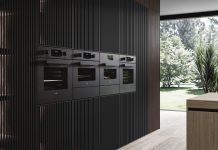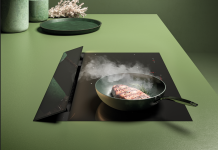What are the main changes that suction hood manufacturers will have to face in view of the new labels? Is the energy label a market driver? To what extent? To these issues the Appliance Division of Tecniche Nuove Group dedicated the workshop organized last March in the ambit of Mecspe, the primary Italian exhibition for the manufacturing industry.
On March 24th, inside MecSpe exhibition in Parma, they discussed the theme of the energy label for suction hoods and, more in general, what will happen in the market after the introduction of the “new” labels.
Quotations are mandatory: the hood certification is one of the youngest in the household appliance field, nevertheless are in course important changes that will involve an evolution of the product and of the components sharing in its implementation.
Massimo Moscati, editorial director of the Appliance Division of Tecniche Nuove, introduced the topic while Marco Imparato, General Manager of Ceced Italia opened the proceedings of the workshop, organized by the reviews HA parts&components, AE apparecchi elettrodomestici and Home Appliances World. And it was an optimistic start: the history of the Italian hood is successful and today Italian hoods represent 10% of the world production. The challenges this segment will have to accept include the global competition, the connectivity and precisely the new energy label.
The speech by Roberto Fogliata, Group Account Manager of Gfk, has moved the focus on consumers and their approach to energy saving themes, outlining an identikit through data and statistics. The energy label is an important market driver, supporting the growth of big appliances, allowing a reduction of energy consumptions and justifying a premium price for high-efficiency models. The specific hood trend has constantly grown in Europe over the years; in Italy, in 2016 the market of hoods –and of cookers – started rising again.
Alessio Roselli, electrical&electronics Appliances laboratory manager Imq, analysed the performances and tests for the hood certification, starting from the legislative framework and encompassing the regulatory one, to illustrate testing methods and related instruments for various parameters, such as the volumetric airflow, the grease absorption, the lighting efficiency of the hood, the measurement of the fluid-dynamic efficiency and noise.
Protagonists of the technical speeches of the day were four companies operating in the hood design, manufacturing and testing chain. Rosalino Usci, R&D manager of 3P engineering, presented the test benches for the energy labelling and the product development, a fundamental support for manufacturers both in the design and testing phase of hoods.
Felice Fazio, general manager of Altec, narrated the solution stemmed from the partnership with Oldrati Group, Oldrati led kit. It is a new led-light gasket, with applications in the big appliance sector, able to grant long-term sealing and lighting quality under extreme application conditions owing to temperature, presence of steam and greases.
Marco del Gatto, laboratory manager of Sifim, highlighted the factors that influence the filter performances, then the hood typology, the position of the filter on the hood and the operation parameters of hood speed and airflow; then he illustrated his test laboratory.
With Fulvio Perez, managing consulting of Sisme, spotlights were displaced on one of the main “defendants” in the hood energy consumption: the motor. The research is precisely progressing in this ambit, still involving a collaboration between producers and component manufacturers, to find efficient solutions at low cost.
The final part of the meeting was dedicated to the speeches by the finished product manufacturers attending the workshop: Francesco Faginoli from Faber, Fabrizio Porcarelli from Fabita, Luigi Scattollini and Ivan Mancinelli from Best, Lorenzo Baraldi from Cappe Baraldi.




